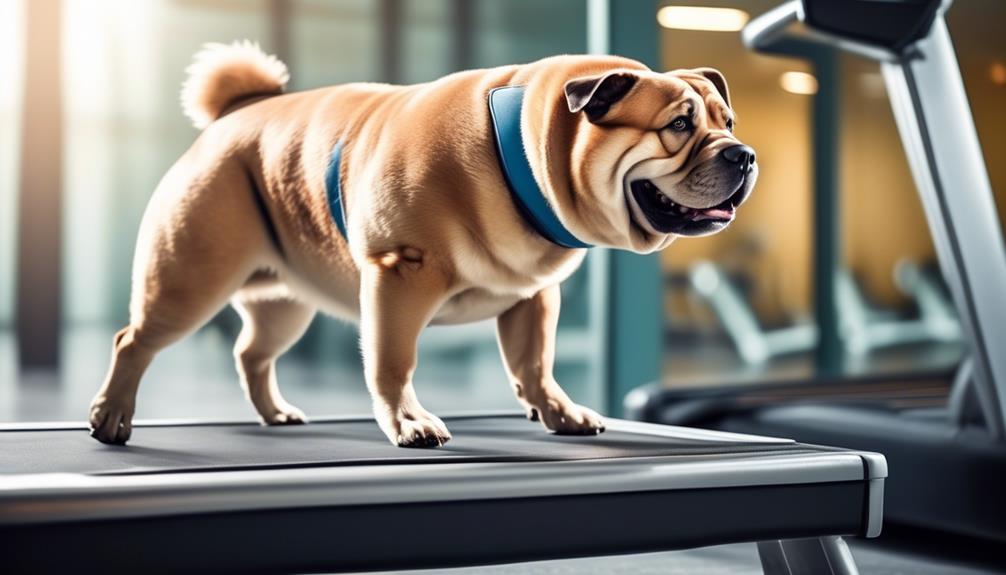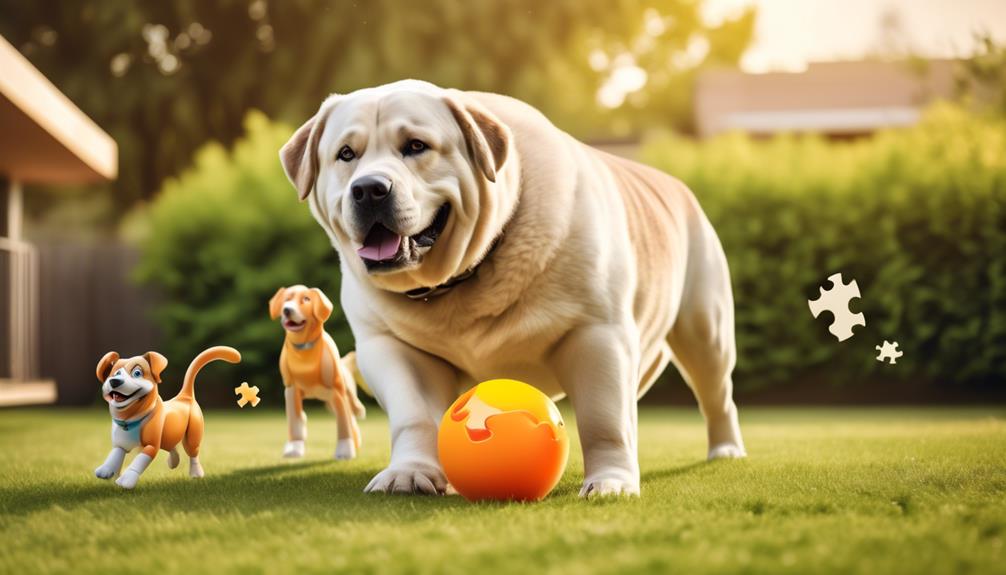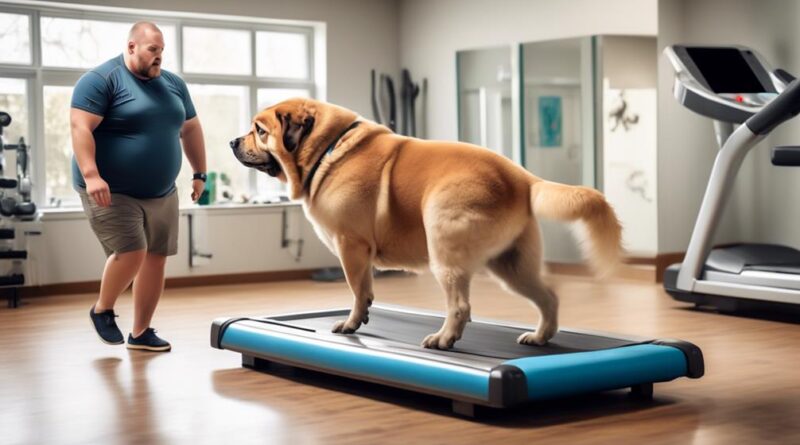What Are Effective Exercise Routines for Overweight Dogs?
If you've noticed your furry friend carrying a few extra pounds, you might be wondering how to help them shed the weight and improve their overall health. While it's easy to feel overwhelmed by the plethora of advice out there, finding effective exercise routines for overweight dogs doesn't have to be complicated.
By understanding the unique needs of overweight dogs and incorporating tailored exercise plans, you can make a significant difference in their well-being. So, how exactly can you create a routine that suits your dog's needs and helps them achieve a healthier lifestyle?
Understanding Overweight Dog Health
Understanding the health implications of overweight in dogs is crucial for their well-being and longevity. Weight management plays a significant role in maintaining your dog's overall health. Just like in humans, being overweight can lead to a variety of health issues in dogs, including diabetes, arthritis, and heart disease. It's important to recognize the signs of overweight in your dog, such as difficulty breathing, increased fatigue, and reluctance to exercise.
Dietary restrictions are a key component of weight management for dogs. It's essential to provide your dog with a balanced diet that meets their nutritional needs while controlling their caloric intake. This may involve feeding them smaller portions or switching to a specially formulated weight management dog food. Additionally, treats should be given sparingly and in moderation.
Regular exercise is also crucial for weight management in dogs. Daily physical activity can help them burn off excess calories and maintain a healthy weight. Incorporating activities such as walks, hikes, or playtime in the yard can make a significant difference in your dog's overall fitness. Not only does exercise aid in weight management, but it also provides mental stimulation and strengthens the bond between you and your furry friend.
Importance of Regular Exercise
Recognizing the health implications of overweight in your dog, it's essential to emphasize the importance of regular exercise in maintaining their overall well-being and longevity. Regular physical activity offers numerous health benefits for your canine companion, especially when it comes to weight management. Here's why incorporating regular exercise into your dog's routine is crucial:
- Weight Management: Regular exercise plays a pivotal role in helping your overweight dog shed those extra pounds. It increases their metabolic rate, burns calories, and helps them maintain a healthy weight, reducing the risk of obesity-related health issues.
- Cardiovascular Health: Engaging in activities such as brisk walks, swimming, or running not only helps in weight management but also strengthens the heart and improves overall cardiovascular health in your dog.
- Joint Health: Exercise helps in maintaining joint flexibility and strength, which is particularly important for overweight dogs, as excess weight can put strain on their joints, leading to discomfort and potential joint problems.
- Mental Stimulation: Regular physical activity provides mental stimulation, reducing boredom and destructive behaviors. It also promotes a sense of happiness and overall well-being in your furry friend.
Incorporating regular exercise into your dog's routine not only aids in weight management but also contributes significantly to their overall health and happiness. So, lace up those walking shoes and get your furry friend moving for a healthier and happier life!
Low-Impact Exercise Options

To provide gentle and effective exercise for your overweight dog, consider incorporating low-impact activities into their routine. Low-impact exercises are especially beneficial for overweight dogs as they reduce the stress on their joints while still providing a good workout.
Swimming is an excellent low-impact exercise option for overweight dogs. It provides a full-body workout while being gentle on the joints. The buoyancy of water supports the dog's weight, reducing the impact on their joints and making it an ideal exercise for overweight or arthritic dogs. Additionally, swimming benefits dogs by helping them build muscle strength and cardiovascular endurance without putting excessive strain on their bodies.
Another great option for low-impact exercises is walking on soft surfaces such as grass or sand. These surfaces are easier on the joints compared to hard pavement and can provide a good low-impact workout for overweight dogs. Additionally, controlled leash walking and gentle incline walking can help improve their stamina and overall fitness without putting too much pressure on their joints.
Engaging in joint-friendly activities such as slow-paced fetch or playing with interactive toys can also provide mental stimulation and light exercise for overweight dogs. These activities can help them burn calories and stay active without causing any harm to their joints.
Creating a Structured Walking Routine
Incorporating a structured walking routine for your overweight dog builds upon the low-impact exercises mentioned earlier, providing a consistent and beneficial form of physical activity. Here's how you can create an effective walking routine for your furry friend:
- Consistency: Aim for daily walks, gradually increasing the duration as your dog's stamina improves. Consistency is key for weight management and overall health improvement.
- Pace and Distance: Start with shorter walks at a slower pace, gradually increasing both the pace and distance over time. This helps in preventing strain and fatigue while promoting weight loss.
- Structured Playtime: Integrate short play sessions during the walks to keep your dog engaged and active. This could include playing fetch or incorporating small challenges like navigating through obstacles.
- Monitoring Progress: Keep track of your dog's progress by noting improvements in stamina, breathing, and overall mobility. This will help in adjusting the walking routine to suit your dog's increasing fitness levels.
Incorporating Playtime and Interactive Toys

Keeping your overweight dog active and engaged involves incorporating playtime and interactive toys into their daily routine.
Interactive play is an excellent way to provide mental stimulation and physical activity for your furry friend. Interactive toys such as treat puzzles, tug ropes, and hide-and-seek toys can keep your dog engaged and entertained while encouraging movement and exercise.
Treat puzzles are a great way to engage your dog's mind and provide physical activity. These toys often require the dog to figure out how to access the treats hidden inside, promoting problem-solving skills and keeping them active.
Tug ropes are perfect for interactive play, allowing you to engage with your dog while also providing a physical outlet for them to release energy.
Additionally, hide-and-seek toys can be used to hide treats around the house or in the yard, encouraging your dog to use their sense of smell and search for the hidden treasures.
Incorporating interactive play and toys into your dog's routine can help prevent boredom, reduce anxiety, and provide essential mental stimulation. By engaging in interactive play, your dog can stay active and entertained, which is particularly important for overweight dogs in need of exercise.
Remember to rotate the toys regularly to keep the activities fresh and exciting for your furry companion.
Swimming as a Fitness Option
Consider incorporating swimming as a fitness option for your overweight dog to provide a low-impact and enjoyable form of exercise. Swimming is an excellent way for your dog to burn excess calories, build muscle, and improve cardiovascular health.
Here's why swimming is a great fitness option for overweight dogs:
- Low Impact: Swimming is gentle on your dog's joints, making it an ideal exercise for overweight dogs who may struggle with mobility issues.
- Full-Body Workout: Swimming engages multiple muscle groups, providing a full-body workout that can help your dog shed excess weight and improve overall fitness.
- Water Safety: Ensure that the swimming environment is safe for your dog. Use a doggie life vest if needed and monitor your dog closely to prevent any mishaps in the water.
- Canine Hydrotherapy: Swimming can also be a form of canine hydrotherapy, which can aid in weight loss and improve mobility for overweight dogs, especially those with arthritis or joint pain.
When introducing your dog to swimming, start in shallow water and gradually build up their confidence. It's important to make sure your dog enjoys swimming and feels comfortable in the water. If your dog is hesitant, consider enlisting the help of a professional dog swim coach or hydrotherapist to ensure a positive swimming experience.
Always consult with your veterinarian before starting any new exercise regimen for your overweight dog.
Monitoring Progress and Adjustments
If your dog has been swimming regularly, it's important to monitor their progress and make any necessary adjustments to their exercise routine. One of the key aspects of monitoring your overweight dog's progress is tracking their weight. Weigh your dog regularly, such as once a week, to ensure that they're steadily losing weight at a healthy pace. If their weight remains stagnant or increases, it may be an indication that adjustments need to be made to their exercise routine or diet.
In addition to tracking weight, measuring activity levels is crucial. Keep a record of the duration and intensity of your dog's swimming sessions. You can use a fitness tracker designed for dogs or simply keep a journal. By doing so, you can ensure that your dog is consistently engaging in physical activity and gradually increasing their endurance. If you notice that your dog seems fatigued more quickly or isn't making progress in their swimming abilities, it may be necessary to adjust the frequency or intensity of their workouts.
It's important to be attentive to your dog's overall well-being as you monitor their progress. If you notice any unusual changes in behavior, appetite, or energy levels, consult with your veterinarian. Making regular assessments and adjustments to your overweight dog's swimming routine will ensure that they're on the right track to achieving a healthier weight and improved fitness.
Seeking Professional Guidance
To ensure the safety and well-being of your overweight dog during their swimming routine, it's essential to seek professional guidance from a qualified veterinarian or animal fitness expert. Professional guidance can provide tailored support to address your dog's specific needs and ensure that their exercise routine is effective and safe.
Here's why seeking professional guidance is crucial:
- Nutrition consultation, weight management: A qualified veterinarian can assess your dog's nutritional needs and create a customized diet plan to support their weight management goals. Proper nutrition is essential for overall health and can complement the exercise routine to achieve optimal results.
- Behavioral training, motivation techniques: An animal fitness expert can provide guidance on behavioral training and motivation techniques to help your dog stay engaged and motivated during their exercise routine. This can be particularly beneficial for overweight dogs who may face challenges in staying active.
- Specialized exercise recommendations: Professionals can offer specialized exercise recommendations based on your dog's breed, age, and overall health condition. This tailored approach ensures that the exercise routine is suitable and beneficial for your dog's specific circumstances.
- Monitoring and adjustments: Professionals can monitor your dog's progress and make necessary adjustments to the exercise routine as needed. This ongoing support is crucial for ensuring that the exercise routine remains effective and safe as your dog progresses towards a healthier weight.
Seeking professional guidance can provide valuable support in developing an effective exercise routine that meets your overweight dog's unique needs.
Frequently Asked Questions
How Can I Modify My Dog's Diet to Support Their Exercise Routine?
To support your dog's exercise routine, modify their diet by controlling portions and providing balanced meals. Consider adding nutritional supplements to ensure they get the necessary nutrients. This will help them maintain a healthy weight and energy levels.
Are There Any Specific Breeds That May Require Different Exercise Routines for Weight Management?
For specific exercise breeds, weight management challenges may vary. Some breeds like bulldogs and basset hounds may need low-impact exercises due to their body structure, while others like border collies may require more intense workouts.
What Are Some Signs That My Overweight Dog May Be Experiencing Pain or Discomfort During Exercise?
If your overweight dog is experiencing discomfort during exercise, signs like limping, whining, or reluctance to move may indicate pain. It's important to monitor these signs and adjust their exercise routines accordingly for weight management.
Can I Still Incorporate Treats Into My Overweight Dog's Exercise Routine?
Yes, you can still incorporate treats into your overweight dog's exercise routine. Consider using low-calorie treat alternatives like carrots or green beans as exercise rewards to help them stay motivated while managing their weight.
How Can I Help My Overweight Dog Stay Motivated and Engaged During Exercise?
To help your overweight dog stay motivated and engaged during exercise, incorporate mental stimulation and playtime. Use interactive toys and consider agility training. This will keep them interested and excited about staying active.
Conclusion
In conclusion, helping your overweight dog get in shape is essential for their overall health and well-being. By understanding their health needs, incorporating regular exercise, and monitoring their progress, you can create effective exercise routines that cater to their specific needs.
Whether it's low-impact options, structured walking routines, playtime, or swimming, there are plenty of ways to keep your dog active and healthy.
Don't hesitate to seek professional guidance to ensure the best outcomes for your furry friend.
